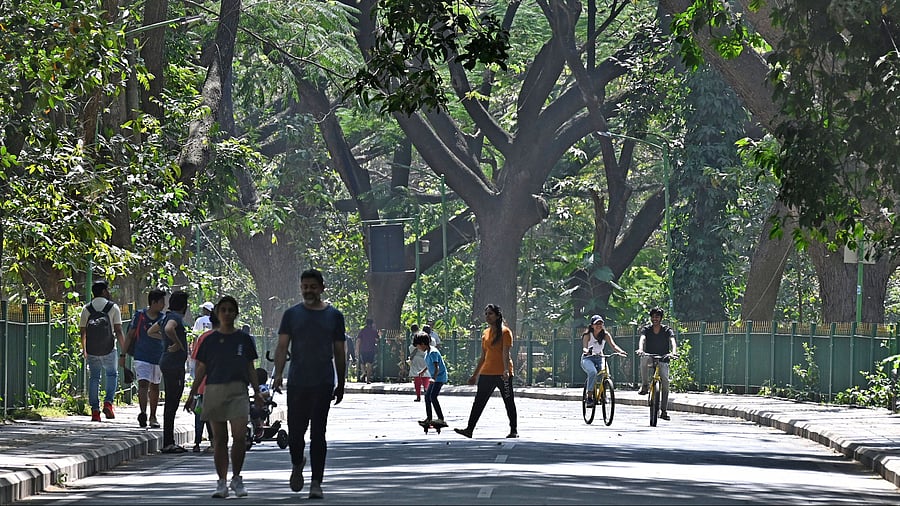
People walking in Cubbon Park.
Credit: DH Photo
There have been repeated attempts to encroach on Bengaluru’s prime lung space, the Cubbon Park. The latest assault comes in the form of an alleged plan to allocate 2.5 acres of land in Cubbon Park for a private art gallery. If true, this would be in violation of the Karnataka Government Parks Act, 1975, which restricts construction and privatisation within protected park spaces.
The Cubbon Park Walkers’ Association has alleged that a survey has been conducted in the park to allot land for the art gallery on the land belonging to the Horticulture Department’s on oral orders from the chief secretary. However, there is no official confirmation on this proposal.
Cubbon Park was originally spread over 100 acres when it was established in 1870 by Sir John Meade, the then acting Commissioner of Mysore.
Over the years, the park was expanded, and at its peak, it covered around 300 acres. However, due to urbanisation, encroachments, and infrastructural developments, the present area of the park is approximately 197 acres.
Attempts to shrink the park by ‘encroaching’ on it will only result in losing this lung space in an increasingly polluted city. Bengaluru has lost 88% of its tree cover since 1973, according to a study by the Indian Institute of Science. Any proposal involving cutting down trees will only lead to an ecological disaster.
Bengaluru’s old-timers recall that Cubbon Park originally extended westward up to Nrupathunga Road and the present Ambedkar Road. The vast triangular area between Police Thimmaiah Circle, Gopal Gowda Circle, and Basaveshwara Statue was once part of the British Residency Compound, where the British Resident lived under the Union Jack.
When India gained independence in 1947, the British vacated the Residency, transferring its buildings, furniture, paintings, library, crockery, and other artefacts to the Indian administration. The Residency area, once highly wooded and formally landscaped, was gradually repurposed. Over time, this transformation led to the establishment of prominent structures such as the Raj Bhavan, Vidhana Soudha, and the Legislators’ Home.
The history of Cubbon Park has been marked by persistent encroachments. Government buildings and other constructions have gradually reduced the park’s original expanse. For instance, during the tenure of horticulturists such as Rao Bahadur H C Javaraya and G H Krumbigal, strict opposition was raised against any unauthorised constructions within the park.
Javaraya even considered resigning over the issue of erecting the Victory Memorial Building between the Victoria Statue and the High Court. However, the continuous process of urban expansion and bureaucratic decisions led to the irreversible fragmentation of the parkland.
The extension of the Legislators’ Home, leading to a reduction of Cubbon Park by 46 acres, occurred in 1998. In response to such encroachments, the Karnataka Government had earlier passed the Karnataka Government Parks (Preservation) Act in 1975, aiming to protect parks from further constructions. Despite this, the park’s area has diminished over the years due to various infrastructural developments. Notably, a government notification in November 2015 redefined the park’s boundaries, reducing its size from 245 acres in 1998 to 197 acres.
Given Bengaluru’s reputation as a ‘Garden City,’ it is imperative to strike a balance between development and environmental conservation. The government must ensure that any land repurposed from Cubbon Park is strictly regulated, preventing further erosion of this historic green space.
Public cooperation is essential in safeguarding the city’s green heritage. There have been instances where citizens have accepted minor land reallocations under strict assurances that no further encroachments would occur—such as near the Legislative Home and Basaveshwara Statue. However, such assurances need to be legally binding and strictly enforced to prevent future violations.
Moreover, the ill-advised practice of covering heritage rock gardens with debris or obstructing views with high walls should be reconsidered. Lowering such barriers and maintaining greenery can enhance the aesthetic and environmental harmony of these spaces.
Any new proposal should not be viewed merely as a policy matter but as a crucial decision that will shape Bangalore’s urban identity for future generations. While administrative needs must be met, they should not come at the cost of ecological and cultural heritage. Thoughtful urban planning, historical awareness, and active citizen participation are vital in preserving the integrity of Cubbon Park and similar green spaces
in the city.